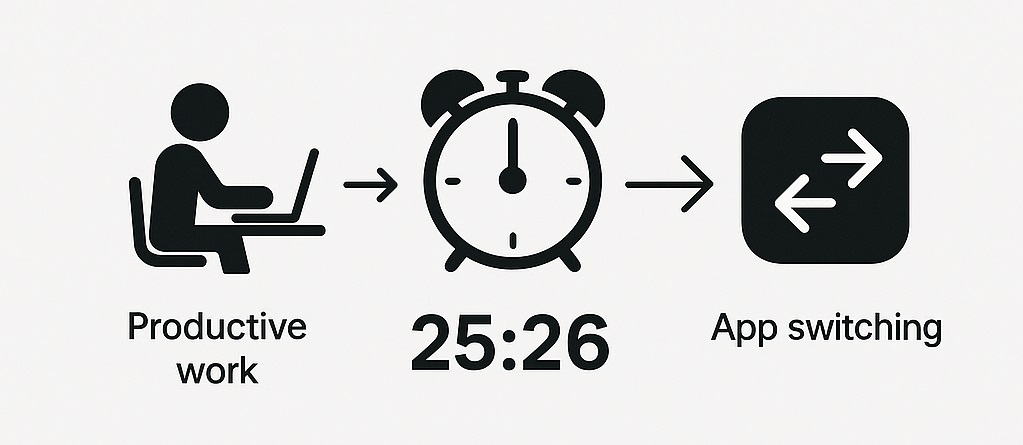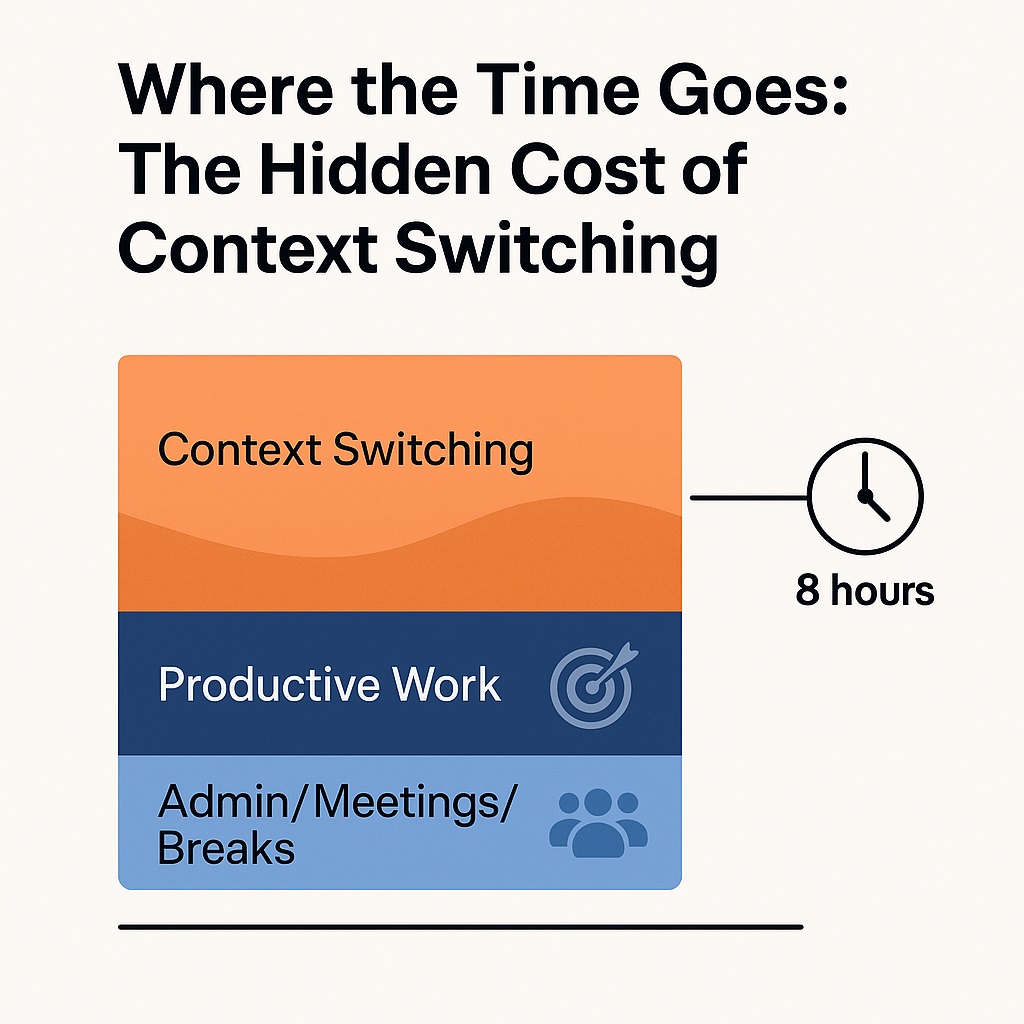The Context Switching Crisis: Why SAP Users Lose 4.3 Hours Daily
The Context Switching Crisis: Why SAP Users Lose 4.3 Hours Daily
In boardrooms across enterprise organizations, executives ask the same persistent question: "Why does everything take so long?" Despite multi-million-pound investments in SAP systems designed to streamline operations, many organizations find their business processes moving slower than ever. The answer isn't found in system performance metrics or user adoption rates—it lies in a hidden productivity crisis that affects every SAP user, every day.
The 25-Minute Recovery Reality
Research from the University of California, Irvine, reveals a startling truth about modern workplace productivity: it takes an average of 25 minutes and 26 seconds to fully return to productive work after switching between applications. For SAP users who average 10.2 application switches daily, this translates to 4.3 hours of lost productive time per person, every single day.
This isn't theoretical workplace research—it's measurable productivity hemorrhaging that directly impacts your organization's bottom line. When your finance manager receives a purchase order notification via email, switches to SAP to review transaction details, then moves to Microsoft Teams to discuss the decision with colleagues, she's trapped in a productivity maze that costs £129 per day per user.
The irony is profound: organizations invest heavily in SAP to create integrated business processes, then systematically fragment those processes across disconnected communication channels. Every approval becomes a context-switching exercise that delays decisions, frustrates employees, and erodes the return on investment that justified the SAP implementation.

Understanding Context Switching in Enterprise Environments
Context switching differs fundamentally from simple multitasking. While multitasking involves juggling multiple activities simultaneously, context switching requires complete mental reorientation between different cognitive frameworks. Each switch demands precious cognitive resources to save current context, load new context, process information in the new environment, and eventually reconstruct the original mental state.
In SAP environments, context switching manifests across multiple dimensions:
Application Context Switching occurs when users move between SAP modules, email systems, collaboration platforms, mobile applications, and various business tools throughout their workday. Each application operates with different interfaces, navigation patterns, and information architectures.
Process Context Switching happens when users interrupt complex analytical work—such as financial reconciliation or procurement analysis—to handle urgent approval requests, then struggle to reconstruct their original analytical framework.
Communication Context Switching forces users to navigate between different communication protocols: SAP workflow notifications, email discussions, Teams conversations, and phone calls, each with distinct response expectations and information structures.
Mental Context Switching represents the cognitive overhead of shifting between different types of thinking: analytical SAP reporting work, collaborative email discussions, strategic planning conversations, and administrative task management.

The Research Foundation
Multiple peer-reviewed studies and large-scale workplace analytics research document the devastating impact of frequent context switching on knowledge worker productivity.
The UC Irvine Interruption Studies
Dr. Gloria Mark's comprehensive research at UC Irvine tracked knowledge workers across diverse organizational environments, measuring actual productivity impact from workplace interruptions and application switching. The study's key finding—25 minutes and 26 seconds average recovery time—challenges common assumptions about brief interruptions having minimal impact.
For SAP users working on complex business processes such as month-end financial close procedures or multi-step procurement workflows, these interruptions prove particularly costly. The cognitive overhead of remembering transaction codes, data relationships, and process states makes SAP work especially vulnerable to context switching penalties.
Asana's Anatomy of Work Research
Asana's global workplace study surveyed thousands of knowledge workers, revealing that the average employee switches between nine different applications daily. More concerning, 56% of workers report feeling pressure to respond to notifications immediately, creating a constant state of potential interruption that prevents sustained focus on complex tasks.
This research highlights a critical challenge for SAP organizations: the productivity tools designed to improve efficiency often create productivity bottlenecks. When SAP users must monitor email for workflow notifications, check Teams for colleague discussions, access mobile apps for approvals, and return to SAP for transaction processing, the cognitive load becomes overwhelming.
The study found that workers lose track of approximately 26% of their daily tasks due to poor coordination between different applications and communication channels. For SAP processes involving multiple stakeholders and approval chains, this lost task awareness creates significant business risk.
The Flow State Research
Collaboration between Qatalog and Cornell University's Idea Lab focused specifically on deep work and flow states in modern workplace environments. Their findings demonstrate that it takes an average of 9.5 minutes to regain productive workflow after switching between digital applications—and this represents the minimum recovery time for simple task transitions.
Complex SAP work requiring sustained concentration—financial analysis, system configuration, data migration projects, strategic business process design—suffers even greater productivity losses from context switching interruptions.
The research revealed that professionals experiencing frequent application switching report significantly lower job satisfaction and higher stress levels, creating a compounding problem where context switching not only reduces immediate productivity but also contributes to long-term employee engagement challenges.

The SAP-Specific Context Switching Challenge
Enterprise resource planning systems create unique context switching vulnerabilities due to their complexity and integration with multiple business communication channels.
Email-Dependent Workflow Architecture
Most SAP implementations rely heavily on email for workflow notifications and approval processes. This pattern emerged when email represented the primary digital communication tool and workers spent entire days at desktop computers with reliable network connections. However, this architecture creates systematic context switching challenges:
Notification Fragmentation: A single purchase requisition approval forces users to maintain mental context across multiple applications—SAP for transaction details, email for notifications, and potentially Teams or phone calls for stakeholder discussions.
Asynchronous Communication Delays: Email-based workflows assume recipients will prioritize SAP-related notifications appropriately among the average 121 emails received daily, making critical business approvals easy to overlook or postpone.
Mobile Access Limitations: While email functions adequately on mobile devices, most SAP systems provide limited mobile functionality, forcing remote workers to delay decisions until they can access full desktop interfaces.
The Modern Workforce Reality
The shift toward remote and hybrid work arrangements fundamentally changed how people interact with enterprise software, amplifying existing context switching challenges:
Remote Work Statistics: According to the U.S. Bureau of Labor Statistics, 34-35.5 million people work from home, representing a permanent transformation in workplace patterns that SAP workflows must accommodate.
Teams-First Collaboration: Microsoft Teams and similar platforms have become the central hub where modern work happens, yet most SAP processes remain isolated from these collaboration environments.
Mobile Decision Expectations: Modern professionals expect to make business decisions anywhere, anytime, through mobile-optimized interfaces that traditional SAP workflows cannot support effectively.
Calculating the True Productivity Cost
The financial impact of context switching extends far beyond theoretical productivity concerns. Using conservative assumptions based on established research, organizations can quantify their actual losses:
Base Calculation: 10.2 daily context switches × 25.4 minutes average recovery × £50 hourly compensation = £215 daily productivity loss per SAP user.
Annual Impact: £215 daily loss × 230 working days = £49,450 annual productivity loss per user.
Organizational Scale: For a 100-user SAP organization, this represents £4.945 million in annual productivity losses.
These calculations use conservative assumptions and don't include additional costs from increased error rates, delayed decision-making, reduced collaboration effectiveness, and employee satisfaction deterioration that research consistently associates with frequent context switching.
The Strategic Integration Opportunity
The solution to SAP context switching challenges isn't found in training users to work more efficiently within fragmented systems, but in bringing SAP workflows into the collaboration environments where modern work actually happens.
Microsoft Teams integration represents the most strategic approach because Teams is already deployed, security-approved, and adopted in most enterprise organizations that run SAP systems. Rather than forcing users to switch between disconnected applications, Teams integration brings ERP processes into the natural flow of business conversation and collaboration.
Platforms like Looply enable organizations to integrate SAP workflows with Teams without the complexity and risk associated with custom development projects. By leveraging pre-built connectivity and enterprise-grade security frameworks, organizations can eliminate context switching while enhancing mobile access, collaboration capabilities, and process visibility.
The Path Forward
Context switching represents more than an operational efficiency challenge—it's a strategic business issue that affects every aspect of organizational performance. When your most valuable employees spend more time navigating between applications and overcoming interruptions than making decisions, when approval processes designed for desktop environments cripple mobile workforces, and when multi-million-pound SAP investments operate through fragmented email workflows, your organization faces systematic competitive disadvantage.
The research is clear, the costs are quantifiable, and proven solutions exist. Organizations that recognize and address the hidden productivity crisis of context switching will gain sustainable competitive advantages, while those that continue accepting fragmented workflows will find themselves at increasing disadvantage in operational efficiency, employee satisfaction, and market responsiveness.
Ready to quantify your organization's context switching costs and explore integration solutions?
Download the Complete Analysis: "The Hidden Productivity Crisis in SAP Organizations"
This comprehensive white paper provides detailed cost calculation frameworks, implementation roadmaps, and strategic guidance for transforming SAP productivity through Teams integration. Join hundreds of SAP professionals who have used this research to build compelling business cases for workflow transformation.



